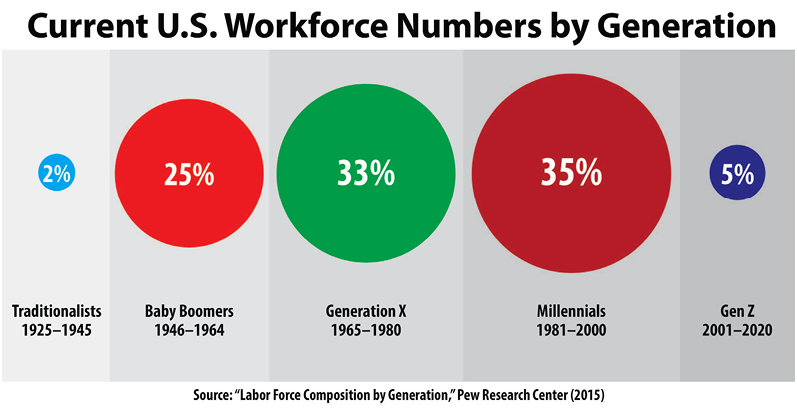Benefits of a Multigenerational Workforce


Among the other challenges faced by companies these past few years, an employee dynamic that was growing long before COVID is the fact that now as many as five different generations of employees make up the workforces of many companies. As average life spans increase, employees stay in the workforce longer and longer – with younger generations being added as the decades roll on. However, if the various strengths of these generations are managed properly, multigenerational workforces can actually be an opportunity – allowing employers to better compete in their industries. How can companies tap into this potential?
Each generation of worker has different strengths, needs and concerns. Their work styles, preferred communication methods and expectations can cause conflict. However, if management seeks to understand each generation’s unique qualities, they can harness each group’s strengths and find ways to build their teams to respect generational differences and work more closely together. This can result in a real competitive advantage in the market.
So who are these generations?
- Generation Z
- Millennials
- Generation X
- Baby Boomers
- Silent Generation
Beyond just age difference, these generations were shaped differently by their experience with (or lack of) technology, the cost of their education (and educational debt), whether they entered the workforce during a boom or a recession, and how they feel as a generation about social and environmental issues. Throughout this month, we will dig deeper into the mindset of each of these generations, with the purpose of better understanding them and learning how to better communicate across generations, to learn each generation’s strengths and how to best engage, and to reward and incentivize them to bring out the best in all employees – no matter the generation.
Benefits of a Multigenerational Workforce
There are a host of benefits from having multiple generations in your workforce. Here are just a few:
Multiple Perspectives – Different generations have different ways of looking at their jobs and how to handle responsibilities. Sharing different views will expand the perspectives of all generations involved.
Problem-Solving Abilities – Older employees have more experience and history in the industry, but younger generations may have more experience and skill with technology options and communicating with these younger generations. Teaming up generations on projects can result in more creative solutions to problems.
Family Knowledge-Sharing Culture – Recruiting talent has never been more difficult, so the need to retain employees and train them for the long-term is more important than ever. Companies with many generations of employees can tap into the older generations to mentor & train younger staff. In addition, a mentor/mentee culture in a company creates unique multigenerational bonds that mimic the family structure and lead to greater job satisfaction for everyone.
Some Ways to Bridge the Gaps
Understand that different generations have different work styles and preferences of communicating. Make sure that managers are aware of the ways their reports prefer to work and try to accommodate their styles. Gen Zers and employees with children may prefer working remotely and with flexible hours. Even your oldest employees may stay longer if they are given flexibility with their hours. Also, make sure to communicate with your teams in various ways. Some may prefer digital communication, while others prefer face-to-face interactions, hard copy information sheets or phone calls.
Younger generations want career development and to be heard. Older generations want to be recognized for the contributions and experience they provide. Pair up younger employees with senior staff member as mentors that can help guide them and transfer important job skills. Both will benefit, and in the process learn to appreciate each other more – dampening negative stereotypes of the other’s generation.
Finally, while there are general commonalities within various generations, it is more important to understand your individual team members and reports. Each person has unique life experiences that shape them. If managers seek to better understand each employee’s needs, motivations, hopes and dreams, they will be able to access their full potential, better engage them, and provide rewards and incentives that are truly meaningful for them individually.
By Ann Condon, Marketing Manager
Ann Condon has been with Dion for 17 years, working in Dion’s Marketing and Business Development Department. Although this was her first position with a jewelry manufacturer, she has learned a lot over the years. Ann enjoys getting involved in “All Things Dion” from volunteering at the Dion Golf Tournament to being a part of the Dion Diamonds Relay for Life Team. She has quite a number of Dion event t-shirts to show for it!
Sources
How to Manage the 5 Generations in the Workplace
Last Updated July 26, 2019
The 37-Year-Olds Are Afraid of the 23-Year-Olds Who Work for Them
By Emma Goldberg
Oct. 28, 2021
Understanding Today’s Multigenerational Workforce: Benefits, Challenges, and 9 Best Management Practices
Posted by Andrea Boatman